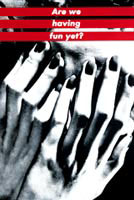Sudden impact
The number of designers who have successfully made the move to the art world can be counted on the fingers of one hand; for most people one of those fingers would have to be American graphic designerturned-art editor-turned-artist, Barbara Kruger.

Art and design: double act, joint package, twinned towns in design education, so why in the real world is art generally seen as high concept, design as low? In simple terms, because design is ultimately a trade, a job, a paid solution to a client’s problem. Yet, as AMX director Malcolm Garrett points out: “The end results of art and design practice may well be indistinguishable from one another in purely visual terms. But the deciding factor is that the ‘intention’ of those end results (and often the environment within which they are seen) are seldom, if ever, the same.”
Few designers have been able to radically change the perception and context of that end result. It’s true that boundaries are blurring in all the creative forms and it’s also true that design this century has been afforded increasing respect, critical theory and cultural analysis. But the number of designers who have successfully made the move to the art world can be counted on the fingers of one hand; for most people one of those fingers would have to be American graphic designerturned-art editor-turned-artist, Barbara Kruger.
For more than 20 years Kruger has married text and imagery to create highly visible and highly politicised pieces (in both the personal and general sense). By placing them outside the gallery – on billboards, bus shelter posters, placards, T-shirts, TV spots, magazine covers and so on, these pieces make an impact on us as they use the visual grammar of design and advertising to present challenging social and sexual issues around the idea of power.
Londoners haven’t had a chance to assess this impact since 1983, when Kruger showed at the Institute of Contemporary Arts, but a large-scale installation opening next week at the South London Gallery promises to place the artist’s new work firmly in the public eye. Comprising written messages, acoustics, photography and video projection, Power, Pleasure, Desire, Disgust assaults the senses: large changing heads recite Kruger aphorisms, text covers the entire space and slides and videos add to the cacophony.
Now in her 50s, Kruger has been an artist for 30 years, shifting from an already impressive career in graphic design. By the age of 22 she was head designer on Condé Nast’s Mademoiselle magazine, then spent a decade on national fashion magazines, where, she said, “I learned to deal with an economy of image and text which beckoned and fixed the spectator. I learned to think about a quickened effectivity, a [process of] accelerated seeing and reading which reaches a near apotheosis in television.”
By the late 1970s Kruger was using this process to examine issues of gender, race and class, and specifically the power of the media to shape and influence our thoughts on these issues. Many of her works became influential agitprop pieces employed in various political movements of the 1980s, including women’s and pro-choice movements and Aids activism.
From the outset, words were an essential component of the work, but it wasn’t until 1979 that she united images and text, appropriating found images and sticking text directly on to them to create what she called “photocollages”. Her signature style remains the bold black, red and white artworks made up of found images and text (usually Futura Bold Italic) that is clearly influenced by design: indeed, New York graphic designer Stefan Sagmeister sees her “design background as evident through her obvious use of formal elements [type and half-tone screened photography] usually associated with commercial art”. And, he adds, “Apart from gallery shows she uses commercial distribution channels like postcards/ posters and so on.”
What also makes Kruger’s work so relevant to design is that for her the medium is not the message, rather, the message is the message. It constantly experiments with text, developing its content, structure and presentation to remain innovative, inquisitive and self-exploratory. She has adapted her background to create political art that informs, questions, entertains and speaks volumes; their content and form make viewers question the language, or communication, of public messages, make us think about what we’re told, by whom, and to what end. In a speeded-up culture where everything we see is fleeting – billboard ads from the car window, newspaper headlines glanced at across a tube carriage, magazines read over someone’s shoulder, LED signs in a station – they create a striking and lasting impact.
And their understated nature – the way they fit into everyday life – is where their power comes from. Now that should speak to you as a designer; and if it doesn’t maybe you should rethink your career. Or at least go see her show and ponder on the art/ design question yourself. As Sagmeister says: “Brian Eno says it’s helpful to look at art not as objects, but as a trigger for experiences. Accepting this, we don’t have to argue whether performance is art, or Andres Serrano’s Piss Christ is art, or Kruger’s work for fashion magazines is art it’s all art if someone has had an art experience viewing it.”
Barbara Kruger – Power, Pleasure, Desire, Disgust is at the South London Gallery, 65 Peckham Road, London SE5, from 2 February to 18 March 2001. Tel: 020 7703 9799
-
Post a comment



